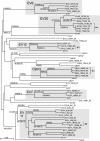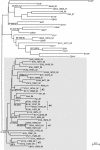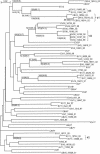Recombination in circulating enteroviruses
- PMID: 12970427
- PMCID: PMC228507
- DOI: 10.1128/jvi.77.19.10423-10431.2003
Recombination in circulating enteroviruses
Abstract
Recombination is a well-known phenomenon for enteroviruses. However, the actual extent of recombination in circulating nonpoliovirus enteroviruses is not known. We have analyzed the phylogenetic relationships in four genome regions, VP1, 2A, 3D, and the 5' nontranslated region (NTR), of 40 enterovirus B strains (coxsackie B viruses and echoviruses) representing 11 serotypes and isolated in 1981 to 2002 in the former Soviet Union states. In the VP1 region, strains of the same serotype expectedly grouped with their prototype strain. However, as early as the 2A region, phylogenetic grouping differed significantly from that in the VP1 region and indicated recombination within the 2A region. Moreover, in the 5' NTR and 3D region, only 1 strain of 40 grouped with its prototype strain. Instead, we observed a major group in both the 5' NTR and the 3D region that united most (in the 5' NTR) or all (in the 3D region) of the strains studied, regardless of the serotype. Subdivision within that major group in the 3D region correlated with the time of virus isolation but not with the serotype. Therefore, we conclude that a majority, if not all, circulating enterovirus B strains are recombinants relative to the prototype strains, isolated mostly in the 1950s. Moreover, the ubiquitous recombination has allowed different regions of the enterovirus genome to evolve independently. Thus, a novel model of enterovirus genetics is proposed: the enterovirus genome is a stable symbiosis of genes, and enterovirus species consist of a finite set of capsid genes responsible for different serotypes and a continuum of nonstructural protein genes that seem to evolve in a relatively independent manner.
Figures





References
-
- Andersson, P., K. Edman, and A. M. Lindberg. 2002. Molecular analysis of the echovirus 18 prototype: evidence of interserotypic recombination with echovirus 9. Virus Res. 85:71-83. - PubMed
-
- Blomquist, S., A. L. Bruu, M. Stenvik, and T. Hovi. 2003. Characterization of a recombinant type 3/type 2 poliovirus isolated from a healthy vaccinee and containing a chimeric capsid protein VP1. J. Gen. Virol. 84:573-580. - PubMed
-
- Cammack, N., A. Phillips, G. Dunn, V. Patel, and P. D. Minor. 1988. Intertypic genomic rearrangements of poliovirus strains in vaccinees. Virology 167:507-514. - PubMed
-
- Caro, V., S. Guillot, F. Delpeyroux, and R. Crainic. 2001. Molecular strategy for ′serotyping' of human enteroviruses. J. Gen. Virol. 82:79-91. - PubMed
MeSH terms
Substances
LinkOut - more resources
Full Text Sources

